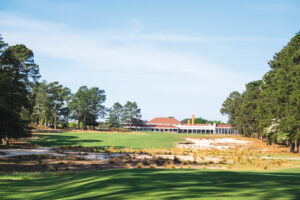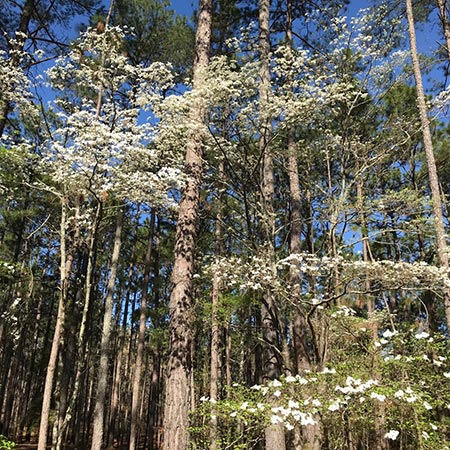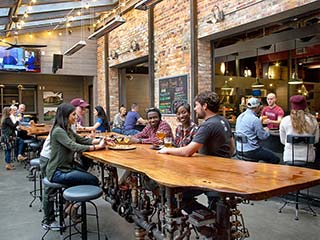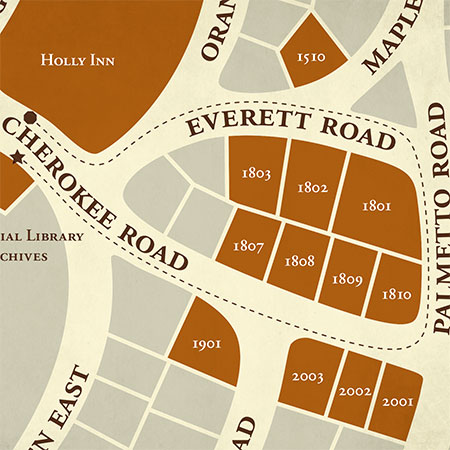2024 U.S. Open: A Look Ahead
2024 U.S. Open: A Look Ahead
By Lee Pace
 The Village of Pinehurst, the broader Sandhills community and the revered No. 2 course are officially in countdown mode as the calendar swings to one year out from the 2024 U.S. Open. Where did 10 years go so quickly since June 2014, the last time the USGA brought its marquee event to the sandy loam and turtleback greens of Pinehurst No. 2? “It’s exciting and energizing when you think that it’s actually here,” John Jeffreys, course superintendent of Pinehurst No. 2, says of the transition from Los Angeles Country Club on Father’s Day 2023 to the 2024 competition to Pinehurst. “The great thing about this golf course is there’s not a lot to be done to it,” Jeffreys says of the transition from resort and member play to having the game’s elite golfers compete for the national championship.
The Village of Pinehurst, the broader Sandhills community and the revered No. 2 course are officially in countdown mode as the calendar swings to one year out from the 2024 U.S. Open. Where did 10 years go so quickly since June 2014, the last time the USGA brought its marquee event to the sandy loam and turtleback greens of Pinehurst No. 2? “It’s exciting and energizing when you think that it’s actually here,” John Jeffreys, course superintendent of Pinehurst No. 2, says of the transition from Los Angeles Country Club on Father’s Day 2023 to the 2024 competition to Pinehurst. “The great thing about this golf course is there’s not a lot to be done to it,” Jeffreys says of the transition from resort and member play to having the game’s elite golfers compete for the national championship.
No. 2 was stripped of acres of lush Bermuda rough during the Bill Coore & Ben Crenshaw restoration in 2010-11 and the extremities rebuilt to mirror the natural landscape of the Sandhills — hardpan sand, wiregrass, pine needles and assorted vegetation. So there is no narrowing of fairways and watering the rough to prepare this course for the U.S. Open. The major difference will be the greens surfaces — they were converted from Penn G-2 bent immediately after the 2014 championship to ultra-dwarf Bermuda, following the trend of the last decade of courses in the Mid-Atlantic “transition zone” to swap bent greens for the more heat-tolerant Bermuda surfaces. “This is the first time the U.S. Open has been played on ultra-dwarf Bermuda,” Jeffreys says. “Generally, they’re a little firmer, a little faster than what we had before. We’ll concentrate leading up to the competition on improving the quality of the ball roll-out, working on the texture of the leaf.”
John Bodenhamer, chief championships officer for the USGA, remembers that there was little rain in the six weeks leading up to the Open in June 2014 and the U.S. Women’s Open that followed behind. “We were blessed with weather that allowed us to control the firmness and playability of course No. 2,” he says. “If the weather is different, we will adjust accordingly. The one aspect of No. 2 that we will be studying very closely once again are the sandy natural areas. We will want to make sure that they are prepared in a manner that presents an appropriate penalty for missing the fairway. Otherwise, we plan to just let Pinehurst be Pinehurst, as Donald Ross’ masterpiece will surely produce another memorable U.S. Open.”
 Bill Coore and Ben Crenshaw both had occasion to be in Pinehurst in the spring of 2023 and applauded the look and texture of the No. 2 course. It was essentially as they left it in 2011 and as champions Martin Kaymer and Michelle Wie saw it in 2014. “It just looked to me like, ‘Go play,’” Coore says. “The presentation is just perfect. It hasn’t changed in nine years. If anything, it’s better.” Adds Crenshaw: “It looked fabulous. There’s not much to do. The bunkers look great. The wire grass is terrific. The greens are beautiful. The outskirts are just striking. Every time I get around it, I get inspired.”
Bill Coore and Ben Crenshaw both had occasion to be in Pinehurst in the spring of 2023 and applauded the look and texture of the No. 2 course. It was essentially as they left it in 2011 and as champions Martin Kaymer and Michelle Wie saw it in 2014. “It just looked to me like, ‘Go play,’” Coore says. “The presentation is just perfect. It hasn’t changed in nine years. If anything, it’s better.” Adds Crenshaw: “It looked fabulous. There’s not much to do. The bunkers look great. The wire grass is terrific. The greens are beautiful. The outskirts are just striking. Every time I get around it, I get inspired.”
The U.S. Open always elicits conversations about the rough, with typical Open rough growing anywhere from two to six inches, depending on the type of grass. In 2006, USGA official Mike Davis introduced the concept of “graduated rough,” maintaining different levels of difficulty depending on how far a drive missed a fairway. Shinnecock Hills in 2018 had four-inch fescue at its thickest point. At Winged Foot in 2020, the USGA ramped the meadow grass up to six inches. The bent grass rough at the Country Club in Brookline for 2022 was between five and six inches.
That’s all a moot point at Pinehurst. There are two cuts of grass on No. 2 — the greens are one, the fairways and tees are the other. That’s in stark contrast to the course’s grooming before the Coore-Crenshaw project, where there were six different lengths of grass on and around the course.

“At Pinehurst, the thought in going ‘natural’ is the player would get way more variety in what they faced when the ball got out of the fairway,” says Jim Hyler, the USGA president when No. 2 was renovated who has a home in the Village of Pinehurst. “It could be a perfect lie or you could be totally dead if you’re up against a clump of wiregrass. Mike and I loved the idea of going natural and removing the Bermuda roughs from No. 2. I think it has worked very well.”
Indeed it has. The countdown is on — just 12 months for guests at Pinehurst Resort to see for themselves before the game’s elite converge in the third week of June 2024.
Chapel Hill-based writer Lee Pace has written about golf in the Sandhills since the late 1980s and has authored a dozen books about clubs, courses and the people who’d made it special over more than a century.




